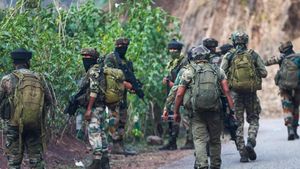Emergency services often face unexpected challenges, and recent events showcase the quick thinking and bravery of responders who save lives under hazardous conditions. From rescuing individuals trapped under vehicles to pulling them from submerged cars, these stories reveal the life-or-death scenarios emergency personnel navigate daily. Here’s a closer look at some recent dramatic rescues and the heroes behind them.
On November 18, 2024, police and firefighters were dispatched to Shay Lane, Hale Barns, following reports of a serious crash involving a pedestrian and a vehicle. Upon arrival, they found the man pinned beneath the vehicle after the collision.
Emergency responders worked quickly, with three fire engines from Altrincham, Wythenshawe, and Cheadle on the scene. They collaborated with the North West Ambulance Service to safely extract the trapped individual. While the man’s injuries remained undetermined, their swift actions prevented what could have been a tragic outcome.
Simultaneously, far from Manchester, the Phoenix police were engaged in another daring rescue effort. On October 31, authorities responded to an unusual incident: a car had become submerged in a swimming pool. The driver, who accidentally pressed the gas pedal too hard, found himself and his vehicle quickly engulfed by water.
Cops arrived on the scene and quickly coordinated their actions to save the driver, emphasizing the importance of training and teamwork. The department's report highlighted how no injuries were reported, showcasing the effectiveness of their prompt response, and leaving everyone wondering how situations like these come about.
The stories of these rescues, filled with both tension and triumph, are testimonies to the bravery and dedication of emergency service members who train rigorously for unpredictable challenges. Such incidents remind communities of the precarious nature of everyday life and the importance of having professionals who stand ready to come to the rescue at any moment.
These events are not isolated but rather part of a broader narrative of emergency management where every minute counts. Every second lost can mean the difference between life and death, and the readiness to respond can be the only lifeline for those caught in precarious situations.
Meanwhile, the rescue missions are carried out with extreme caution, as the risks for the rescuers themselves could escalate. Whether maneuvering under or around large vehicles or responding to unstable conditions near water, the responders often weigh their decisions carefully to prevent adding to the emergency.
The sheer unpredictability of such scenarios poses significant challenges. Just weeks prior to the Shay Lane incident, Greater Manchester Fire and Rescue Service managed another turn of events when they were called to assist individuals from various harrowing situations.
For example, on the shores where flash floods had regularly occurred, rescue teams frequently worked overtime liaising with local authorities to aid stranded motorists and unsuspecting residents. The calls for help poured in as floodwaters rose, and conditions became increasingly dangerous.
Another notable rescue occurred near Varanasi, India, where local law enforcement and volunteers united to save children from being trapped by mudslides. These complex rescues highlighted how community support and teamwork can lead to successful outcomes even within the worst conditions. Social workers and local NGOs often join forces with emergency services to aid families affected by natural disasters.
The collaborative efforts of various organizations have been impactful, often yielding successful rescues and improved community readiness. Such joint efforts become more prevalent as emergency agencies adopt community engagement strategies, which aim to empower locals to aid during crises.
Returning to the U.S., the Shafer family of Phoenix was ever grateful for the police’s intervention during the incident on Halloween. The whole episode unfolded eerily when bystanders noticed the submerged car and quickly dialed 911. Officers, alerted to the scenario, were able to swiftly free the trapped driver.
“I thought I was done for,” said the driver, thankful for the paramedics and police once the situation calmed. “They came right to me and pulled me out.” While narratives from survivors are filled with relief, they often highlight the perilous scenario they faced only moments before. This reflects the unpredictable nature of life, reminding us all of the fine line between safe and unsafe.
The ramifications of such extraordinary rescues extend beyond just the immediate danger, reestablishing faith within communities about local responders. The encounters bond officials with locals who may otherwise feel distanced from emergency services. Residents often take the opportunity to thank responders personally, establishing connections founded on shared respect and gratitude.
These rescues not only save lives but reform perceptions about emergency services' roles within communities. Through storytelling and involvement, police and rescue teams can bridge gaps and reinforce trust, creating allies out of previous strangers. Safety demonstrations at schools and community centers about emergency awareness have also become more common, as making the public informed about safety can sometimes intervene before crises happen.
While these heart-stopping events can dominate the headlines, it is imperative to recognize the systematic training and exercises responders engage within their ranks. These trainings encompass various scenarios ranging from vehicle entrapment, swift water rescue, high-angle rescues, and even search-and-rescue operations during flooding.
The importance of continuous education cannot be overstated. Refresher courses provide devout training to stay sharp and ready for any unusual circumstance lurking around the corner. Gripping narrative scenarios fuel their commitment, continuously reminding them of lives at stake. These are just as real for responders as they are for those at the receiving end of emergency treatments.
Onlookers sometimes capture these events on their smartphones, sharing snippets of the heroic deeds online. Social media becomes the modern-day town crier, bringing immediacy to local arrests, rescues, and accidents. People emotionally resonate with stories of life-saving endeavors and showcase their gratitude through social networks. It's this immediate community feedback loop, facilitated by digital engagement, which raises public esteem for local emergency services.
Through these incidents, questions often arise around safety measures and driver responsibilities, prompting conversations both online and offline. Engaging the community allows for these discussions to flourish, contemplating enhancements for local road safety, systems for aiding the disabled, and the use of emergency vehicles during unpredictable weather conditions.
While we hope incidents like these remain rare, they serve as invaluable tales for community learning. Each individual lifted, free from adversity, signifies the lives built upon the community’s determination to stay united, alert, and ready for anything beyond the mundane life.
These situations exhibit readiness and resilience on display, whether people fight for breath under rising waters or optimism remains under crushing weight. It is the spirit of unity and teamwork, coupled with unyielding resolve within emergency services, which keeps the narrative moving forward with hope, strength, and solidarity for all involved.
The dedication displayed reveals the heart of community service — ready to respond, ready to save, and committed to making the neighborhoods safe. Amidst adversity, this promise shines bright as brighter spots than ever attend every story echoing within every community served, exemplified only by those enduring the extremes of danger but softened by the growing aspirations kindled by camaraderie with their rescuers!



